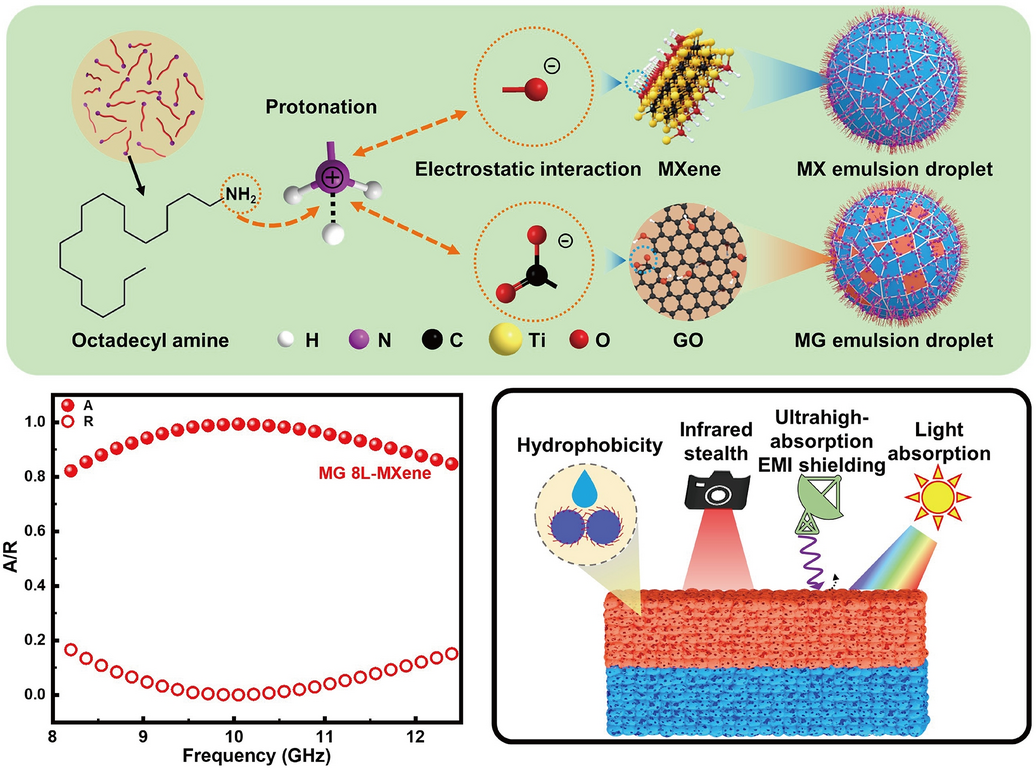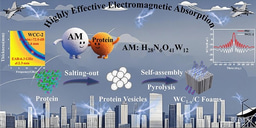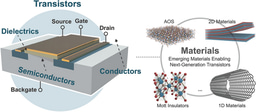Multifunctional Asymmetric Bilayer Aerogels for Highly Efficient Electromagnetic Interference Shielding with Ultrahigh Electromagnetic Wave Absorption
Published in Materials

As 5G base-stations mushroom and drones patrol from the stratosphere, electromagnetic pollution, infrared surveillance, and oil-spill disasters increasingly arrive in the same breath. In a sweeping review published in Nano-Micro Letters, a Beijing University of Chemical Technology team led by Professors Hao-Bin Zhang and Zhong-Zhen Yu reveals an asymmetric MXene-graphene bilayer aerogel that neutralizes all four threats simultaneously. Printed in minutes from a single emulsion ink, the 12 mg cm-3 foam weighs less than a postage stamp yet delivers >100 dB EMI shielding, 115 °C solar-thermal heating, dynamic IR camouflage, 0.032 W m-1 K-1 thermal insulation, and 10× its own weight in oil absorption—all without external power beyond sunlight or a 1–3.5 V pulse.
Inside the Bilayer Design: From Reflection to Re-Absorption
Traditional metal foils reflect 90 % of incident waves, creating secondary pollution. The new design flips the paradigm:
- Top MG layer(MXene + GO) fine-tunes impedance like a gateway, letting waves enter instead of bouncing them away.
- Bottom MXene layer acts as an internal mirror, reflecting any residual energy back through 46 µm spherical closed pores where ohmic loss, dipole polarization, and multiple scattering finish the job.
- Result: an absorption coefficient of 0.95 across 8.2–40 GHz while reflection stays below 0.05—an order-of-magnitude improvement over copper-backed foams.
Finite-element simulations show electric fields trapped inside the spherical pores rather than the aerogel surface, confirming absorption dominance.
Five Missions, One Material
-
Electromagnetic Shielding
3D-printed lattice covers attenuate Bluetooth signals to zero, preserving the >100 dB shielding of copper foil while adding almost no mass. -
Solar-Thermal Heating & De-icing
Under 150 mW cm-2 sunlight, the black MXene surface hits 115 °C in 80 s, melting 0.2 mL of ice in one minute—ideal for aircraft wings or soldier helmets. -
Dynamic Infrared Camouflage
A 1.21 V pulse drives the surface from ambient to 45 °C, matching background heat signatures in real time. Cycle tests over 50 on/off events show <0.5 °C drift. -
Thermal Insulation & IR Stealth
A 1 cm sheet keeps an 80 °C source below 39 °C on the exposed side, cloaking engines from thermal cameras while remaining hand-safe. -
Oil-Water Cleanup
The 131° water-contact-angle surface absorbs cyclohexane in 20 s and viscous crude in 60 s under solar heat, then releases the oil by gentle squeezing—fully reusable after ultrasonic cleaning.
Ink to Infinity—Scalable, Sculptable, Sustainable
The magic starts with a Pickering emulsion ink: MXene and graphene oxide sheets self-assemble with octadecyl amine at the oil-water interface, forming nano-surfactants that jam droplets into a printable gel. Rheology is tuned by stirring speed and phase ratio, enabling direct-ink-writing into lattices, petals, or meter-scale sheets on standard 3-D printers. After freeze-drying, the closed-cell spherical pores survive folding, flexing, and even 3 h of ultrasonic agitation in water.
The entire process uses commodity MXene and GO, no toxic solvents, and is compatible with roll-to-roll molding—clearing the path for kilogram-scale production.
Roadmap to the All-Weather, All-Threat Garment
Next steps embed the aerogel into helmet liners for soldiers, drone skins for logistics, or emergency blankets for disaster zones. Early prototypes already cloak a soldier’s head from IR drones while powering a pocket heater from sunlight alone. One material, five functions, zero compromise—the future of multifunctional protection is ready to print on demand.
Follow the Topic
-
Nano-Micro Letters

Nano-Micro Letters is a peer-reviewed, international, interdisciplinary and open-access journal that focus on science, experiments, engineering, technologies and applications of nano- or microscale structure and system in physics, chemistry, biology, material science, and pharmacy.






Please sign in or register for FREE
If you are a registered user on Research Communities by Springer Nature, please sign in